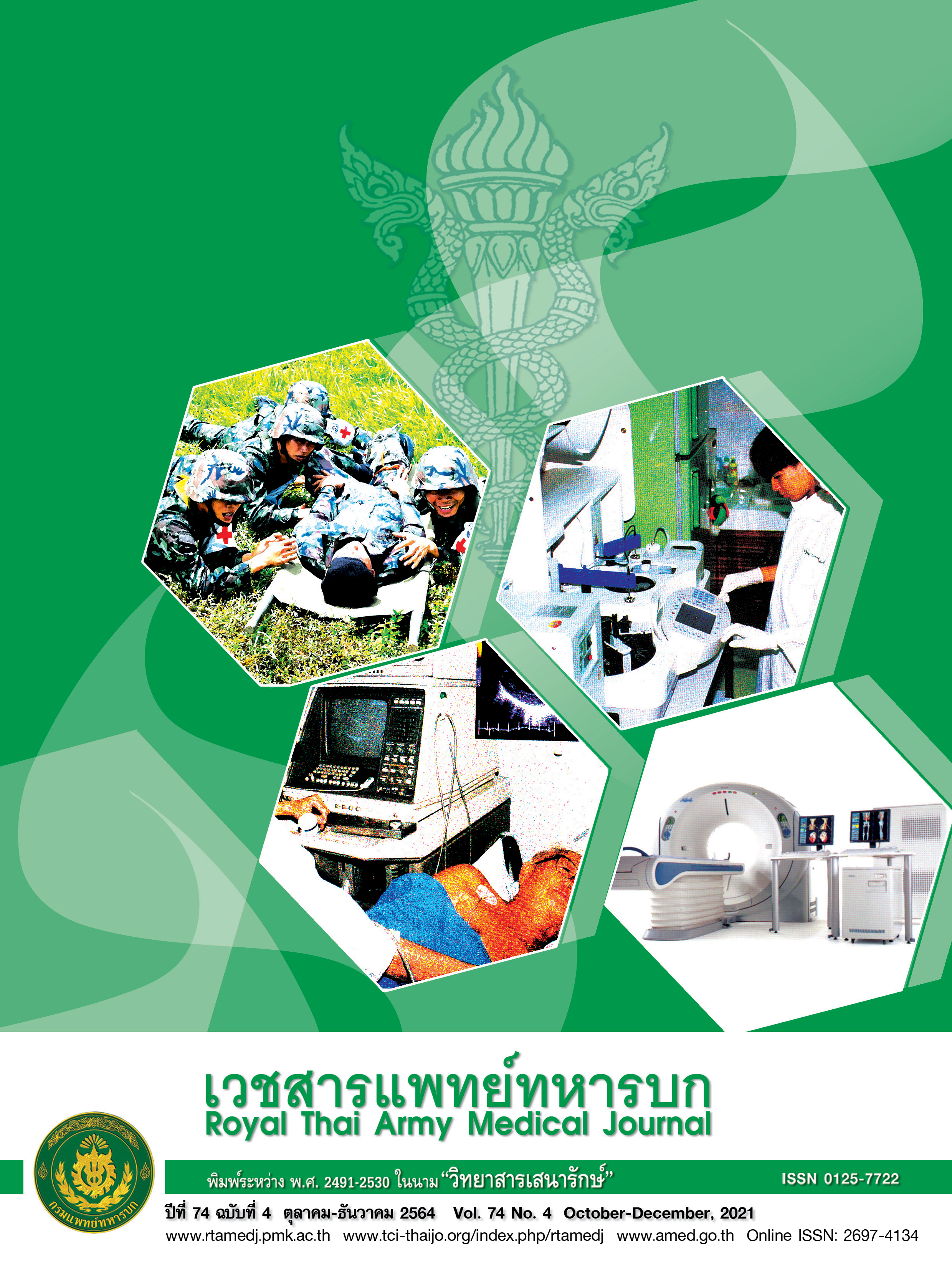Validation of Memorial Sloan-Kettering Cancer Center Nomogram to predict the risk of non-sentinel lymph node metastasis in sentinel node positive in Thai breast cancer patients
Main Article Content
บทคัดย่อ
ความน่าเชื่อถือของตัวชี้วัดของสถาบันมะเร็งเมมโมเรียลสโลนแคทเทอร์ริ่งในการพยากรณ์การกระจายของมะเร็งมาที่ต่อมน้ำเหลืองต่อมอื่นของรักแร้ในผู้ป่วยมะเร็งเต้านมชาวไทย
บทคัดย่อ
บทนำ การผ่าตัดเลาะต่อมน้ำเหลืองบริเวณรักแร้ออกทั้งหมดยังคงเป็นวิธีมาตรฐานในการรักษาผู้ป่วยมะเร็งเต้านมที่มีการกระจายมาที่ต่อมน้ำเหลืองต่อมแรกของรักแร้ อย่างไรก็ตามร้อยละ 40-70 ของผู้ป่วยพบว่าไม่มีการกระจายของมะเร็งมาที่ต่อมน้ำเหลืองต่อมอื่นของรักแร้ ทำให้การผ่าตัดเลาะต่อมน้ำเหลืองบริเวณรักแร้ออกทั้งหมดจึงไม่จำเป็น ปัจจุบันพบว่าสถาบันมะเร็งเมมโมเรียลสโลนแคทเทอร์ริ่งได้พัฒนาตัวชี้วัดในการพยากรณ์การกระจายของมะเร็งมาที่ต่อมน้ำเหลือง อย่างไรก็ตามความแม่นยำของตัวชี้วัดนี้มีรายงานส่วนใหญ่ในผู้ป่วยทางประเทศตะวันตกเท่านั้น วัตถุประสงค์ เพื่อศึกษาความแน่นยำของตัวชี้วัดในการพยากรณ์การกระจายของมะเร็งมาที่ต่อมน้ำเหลืองของสถาบันมะเร็งเมมโมเรียลสโลนแคทเทอร์ริ่งและศึกษาความสัมพันธ์ลักษณะทางพยาธิวิทยาและการกระจายของมะเร็งมาที่ต่อมน้ำเหลืองต่อมอื่นของรักแร้ วิธีการศึกษา เป็นการเก็บข้อมูลในผู้ป่วยที่ได้รับการผ่าตัดเลาะต่อมน้ำเหลืองบริเวณรักแร้ออกทั้งหมดที่เข้ารับการรักษาที่โรงพยาบาลพระมงกุฎเกล้า นำผลที่ได้มาวิเคราะห์แบบหลายตัวแปร ผลการวิจัย ผู้ป่วย 92 รายที่มีการกระจายมาที่ต่อมน้ำเหลืองต่อมแรกของรักแร้ มี 52รายที่มีการกระจายมาที่ต่อมน้ำเหลืองต่อมอื่นของรักแร้ (ร้อยละ 56) การมีการลุกลามของมะเร็งไปที่ทางเดินน้ำเหลืองหรือหลอดเลือด การพบมะเร็งแบบหลายจุด การมีตัวรับแบบเฮอร์ทูมกกว่า 3 บวก เป็นปัจจัยที่พบว่าจะมีการกระจายของมะเร็งมาที่ต่อมน้ำเหลืองต่อมอื่นของรักแร้ ตัวชี้วัดของสถาบันมะเร็งเมมโมเรียลสโลนแคทเทอร์ริ่งแสดงความน่าเชื่อถือได้ดี สรุป การใช้ตัวชี้วัดของสถาบันมะเร็งเมมโมเรียลสโลนแคทเทอร์ริ่งแสดงความน่าเชื่อถือได้ดีในการพยากรณ์การกระจายของมะเร็งมาที่ต่อมน้ำเหลืองต่อมอื่นของรักแร้ในผู้ป่วยมะเร็งเต้านมชาวไทย
Downloads
Article Details
บทความในวารสารนี้อยู่ภายใต้ลิขสิทธิ์ของ กรมแพทย์ทหารบก และเผยแพร่ภายใต้สัญญาอนุญาต Creative Commons Attribution-NonCommercial-NoDerivatives 4.0 International (CC BY-NC-ND 4.0)
ท่านสามารถอ่านและใช้งานเพื่อวัตถุประสงค์ทางการศึกษา และทางวิชาการ เช่น การสอน การวิจัย หรือการอ้างอิง โดยต้องให้เครดิตอย่างเหมาะสมแก่ผู้เขียนและวารสาร
ห้ามใช้หรือแก้ไขบทความโดยไม่ได้รับอนุญาต
ข้อความที่ปรากฏในบทความเป็นความคิดเห็นของผู้เขียนเท่านั้น
ผู้เขียนเป็นผู้รับผิดชอบต่อเนื้อหาและความถูกต้องของบทความของตนอย่างเต็มที่
การนำบทความไปเผยแพร่ซ้ำในรูปแบบสาธารณะอื่นใด ต้องได้รับอนุญาตจากวารสาร
เอกสารอ้างอิง
2. Veronesi U, Paganelli G, Viale G, Luini A, Zurrida S, Galimberti V, et al. A randomized comparison of sentinel-node biopsy with routine axillary dissection in breast cancer. N Engl J Med. 2003; 349:546-53.
3. Giuliano AE, Haigh PI, Brennan MB, Hansen NM, Kelley MC, Ye W, et al. Prospective observational study of sentinel lymphadenectomy without further axillary dissection in patients with sentinel node-negative breast cancer. J Clin Oncol. 2000; 18:2553-9.
4. Turner RR, Ollila DW, Krasne DL, Giuliano AE. Histopathologic validation of the sentinel lymph node hypothesis for breast carcima. Ann Surg. 1997; 226:271-6.
5. Giuliano AE, Hunt KK, Ballman KV, Beitsch PD, Whitworth PW, Blumencranz PW, et al. Axillary dissection vs no axillary dissection in women with invasive breast cancer and sentinel node metastasis: a randomized clinical trial. JAMA. 2011; 305: 569-75.
6. Kim T, Giuliano AE, Lyman GH. Lymphatic mapping and sentinel lymph node biopsy in early-stage breast carcinoma: a metaanalysis. Cancer. 2006; 106: 4–16
7. Van Zee KJ, Manasseh DM, Bevilacqua JL, Boolbol SK, Fey JV, Tan LK, et al. A nomogram for predicting the likelihood of additional nodal metastases in breast cancer patients with a positive sentinel node biopsy. Ann Surg Oncol. 2003; 10:1140-51.
8. Kamath VJ, Giuliano R, Dauway EL, Cantor A, Berman C, Ku NN, et al. Characteristics of the sentinel lymph node in breast cancer predict further involvement of higher-echelon nodes in the axilla: a study to evaluate the need for complete axillary lymph node dissection. Arch Surg. 2001;136:688-92.
9. Kuo YL, Chen WC, Yao WJ, Cheng L, Hsu HP, Lai HW, et al. Validation of Memorial Sloan-Kettering Cancer Center nomogram for prediction of non-sentinel lymph node metastasis in sentinel lymph node positive breast cancer patients an international comparison. Int J Surg. 2013; 11:538-43.
10. Chue KM, Yong WS, Thike AA, Ahmed SS, Li HH, Wong CY, et al. Predicting the likelihood of additional lymph node metastasis in sentinel lymph node positive breast cancer: validation of the Memorial Sloan-Kettering Cancer Centre (MSKCC) nomogram. J Clin Pathol. 2014; 67:112-9.
11. Liu M, Wang S, Pan L, Yang D, Xie F, Liu P, et al. A new model for predicting non-sentinel lymph node status in Chinese sentinel lymph node positive breast cancer patients. PLoS One. 2014 ;9(8):e104117.
12. Krag D, Weaver D, Ashikaga T, Moffat F, Klimberg VS, shriver C, et al. The sentinel node in breast cancer-a multicenter validation study. N Engl J Med. 1998;339:941-6
13. Kohrt HE, Olshen RA, Bermas HR, Goodson WH, Wood DJ, Henry S, et al. New models and online calculator for predicting non-sentinel lymph node status in sentinel lymph node positive breast cancer patients. BMC Cancer. 2008 ;8:66.
14. Saidi RF, Dudrick PS, Remine SG, Mittal VK. Non-sentinel lymph node status after positive sentinel lymph node biopsy in early breast cancer. Am Surg.2004; 70: 101–105
15. Klar M, Jochmann A, Foeldi M, Stumpf M, Gitsch G, Stickeler E, et al. The MSKCC nomogram for prediction the likelihood of non-sentinel node involvement in a German breast cancer population. Breast Cancer Res Treat. 2008;112:523-31.
16. Moghaddam Y, Falzon M, Fulford L, Williams NR, Keshtgar MR. Comparison of three mathematical models for predicting the risk of additional axillary nodal metastases after positive sentinel lymph node biopsy in early breast cancer. Br J Surg. 2010 ;97:1646-52.
17. Hessman CJ, Naik AM, Kearney NM, Jensen AJ, Diggs BS, Troxell ML, et al. Comparative validation of online nomograms for predicting nonsentinel lymph node status in sentinel lymph node-positive breast cancer. Arch Surg. 2011 ;146:1035-40.
18. Cho J, Han W, Lee JW, Ko E, Kang SY, Jung SY, et al. A scoring system to predict nonsentinel lymph node status in breast cancer patients with metastatic sentinel lymph nodes: a comparison with other scoring systems. Ann Surg Oncol. 2008 ;15:2278-86.
19. Tan EY, Ho B, Chen JJ, Ho PW, Teo C, Earnest A, Chan PM. Predictors of nonsentinel nodal involvement to aid intraoperative decision making in breast cancer patients with positive sentinel lymph nodes. ISRN Oncol. 2011;2011:539503.
20. Sasada T, Murakami S, Kataoka T, Ohara M, Ozaki S, Okada M, et al. Memorial Sloan- Kettering Cancer center Nomogram to predict the risk of non-sentinel node metastasi in Japanese breast cancer patients. Surg Today.2012;42:245-9
21. Lambert LA, Ayers GD, Hwang RF, Hunt KK, Ross MI, Kuerer HM, et al. Validation of a breast cancer nomogram for predicting nonsentinel lymph node metastases after a positive sentinel node biopsy. Ann Surg Oncol. 2006; 13:310-20.
22. Sachdev U, Murphy K, Derzie A, Jaffer S, Bleiweiss IJ, Brower S. Predictors of nonsentinel lymph node metastasis in breast cancer patients. Am J Surg. 2002;183:213-7.


